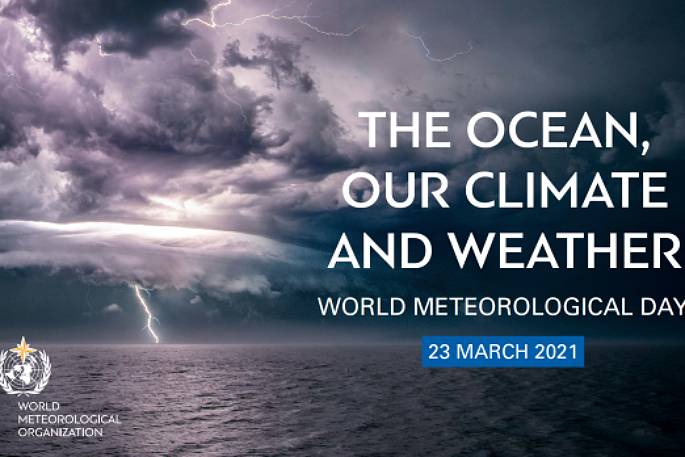John Maunder
sunlive.co.nz

The ocean drives the world’s weather and climate and anchors the global economy and food security. WMO Secretary-General Prof. Petteri Taalas says that this year’s World Meteorological Day on 23 March is devoted to the theme “the ocean, our climate and weather.”
It highlights how observations, research and services are more critical than ever before for more than 70 percent of the Earth’s surface which is simultaneously increasingly vulnerable and perilous.
The ocean acts as the Earth’s thermostat and conveyor belt. It absorbs and transforms a significant portion of the sun’s radiation hitting the Earth’s surface and it provides heat and water vapour to the atmosphere. Enormous horizontal and vertical ocean currents form and circulate this heat around the planet, often for thousands of kilometres, thus shaping the Earth’s weather and climate on global and local scales.
Phenomena such as the El Niño Southern Oscillation are a coupling between the atmosphere and the ocean, and affect temperatures and precipitation and storm patterns in many parts of the globe. El Niño tends to have a warming effect on global temperatures, whilst La Niña has the opposite.
However, the natural ocean/atmosphere equilibrium is increasingly distorted by the effects of human activities. The ocean absorbs over 90% of excess heat trapped by greenhouse gases, thus shielding us from even greater temperature increases as a result of climate change.

The World Meteorological Day theme was selected to highlight the start of the UN Decade of Ocean Science for Sustainable Development (2021 to 2030) spearheaded by UNESCO’s Intergovernmental Oceanographic Commission. WMO is committed to the “safe ocean”, “predicted ocean” and ”transparent ocean” goals of the Decade.
World Meteorological Day takes place every year on 23 March, commemorating the date in 1950 when the Convention establishing the World Meteorological Organization (WMO) came into force. It promotes the 24/7 work of National Meteorological and Hydrological Services in protecting lives and property not just on land but also at sea.
The World Meteorological Organization WMO), is the successor of the International Meteorological Organization (IMO) which was created in 1873. Its fundamental mission is to support the countries of the world in providing meteorological and hydrological services to protect life and property from natural disasters related to weather, climate, and water, to safeguard the environment, and to contribute to sustainable development. This cannot happen without the necessary observations, research and operations that develop the understanding and knowledge of weather and climate.
Since 1961, World Meteorological Day has commemorated the coming into force on 23 March 1950 of the Convention establishing the World Meteorological Organization (WMO) and the essential contribution that National Meteorological and Hydrological Services make to the safety and well-being of society. Each year, the celebrations focus on a theme of topical interest.
The structure of the WMO which has headquarters in Geneva involves the Congress, the Executive Council, and Technical Commissions. The World Meteorological Congress, the supreme body of the Organization, assembles delegates of Members (countries) once every four years to determine general policies for the fulfilment of the purposes of the Organization; to consider membership of the Organization; to determine the general, technical, financial and staff regulations; to establish and coordinate the activities of constituent bodies of the Organization; to approve long-term plans and budget for the following financial period; to elect the President and Presidents of the Organization and members of the Executive Council; and to appoint the Secretary-General.The structure of the WMO is currently under review.
The Executive Council is the executive body of the Organization, which meets annually, implements decisions of Congress, coordinates the programmes, examines the utilization of budgetary resources, considers and takes action on recommendations of regional associations and technical commissions and guides their work programme, provides technical information, counsel and assistance in the fields of activity of the Organization and studies and takes action on matters affecting international meteorology and related activities.
The Council is composed of 37 directors of National Meteorological or Hydrometeorological Services, serving in an individual capacity as representatives of the Organization and not as representatives of particular Members thereof. They include the President and three Vice-Presidents who are elected by Congress, and the presidents of the six regional associations. The remaining 27 members are elected by Congress.
There are also eight Technical Commissions which are composed of experts designated by Members and are responsible for studying meteorological, climatological, and hydrological operational systems, applications and research. They establish methodology and procedures and make recommendations to the Executive Council and the Congress. The Technical Commissions usually meet once every four years, when they elect a President* and Vice-President.
*From 1989 to 1996, I was President of one of Technical Commissions, namely the “Commission for Climatology” . Three other New Zealanders have been Presidents of WMO Technical Commissions, Dr Jim Salinger (Commission for Agricultural Meteorology), Dr Neil Gordon ( Commission for Aeronautical Meteorology), and Dr John Gabites (Commission for Atmospheric Sciences).
BUY Your Own Copy of Dr John Maunders book Fifteen Shades of Climate Today.

Please share so others can discover The BFD.









